The 30-Second Review
The best elliptical provides a high-intensity, low-impact workout with smooth gliding pedals and intuitive controls that require no guesswork. To find them, we consulted physical therapists and everyday buyers before testing the most promising models ourselves. Elliptical design has evolved in recent years from exercise chopsticks to complex machines, and we’ve found the best for a range of budgets.
Best Overall
Simple and smart, the Precor EFX 222 offers a silent motor, smooth motion, and streamlined functionality for $2,495. Together, these features make for a truly superior ride. Compared to other ellipticals, the Precor had the shortest time between powering up and starting our workouts, and we found its motion to be more satisfying than other, more restrictive machines.
Best Budget
Horizon EX-59
Compact and affordable, this machine is minimalist in design but packs a workout punch. We found it sturdy, smooth-riding, and challenging for its price ($999).The constrained up-and-down leg movement isn't as pleasant as what you'll find on more expensive machines, but it was much better than anything else in the Horizon's price range.
Compact and affordable, this machine is minimalist in design but packs a workout punch. We found it sturdy, smooth-riding, and challenging for its price ($999).The constrained up-and-down leg movement isn't as pleasant as what you'll find on more expensive machines, but it was much better than anything else in the Horizon's price range.
Best Upgrade
A springy, cutting-edge machine that features an elongated track to more accurately mimic running strides. March, stride, run, or leap with the suspended pedals on this incredibly designed model. If you want maximum freedom on your elliptical, the FreeStride ($2,999) was the best we found. However, its advanced design takes a while to learn, and we struggled to navigate to the programming we wanted. For most people, the Precor will offer a simpler experience, but the NordicTrack is worth the money for anyone who's super serious about their workouts.
The Best Elliptical Machine
- Precor EFX 222Best Overall
- Horizon EX-59Best Budget
- NordicTrack FreeStride Trainer FS9iBest Upgrade
The best elliptical machine will give you a whole-body workout that keeps your joints happy and your cardio health high. If you can afford to go big, opt for a machine with training perks, suspended pedals, and high adjustability, all of which will help you keep comfortable and motivated in your daily workouts. Looking to save? You’ll sacrifice some of those customizations, but you could pick up some extra portability. Our top picks all offer ergonomic movement and positioning, with a wide range of resistance levels and workout programs.
For a comfortable ride and easy programming, we love the Precor EFX 222. While other ellipticals have programming quirks or non-intuitive controls that frustrated us just trying to start a workout, the Precor provides the tools you need and omits the features you don’t. With a retail price of $2,495, the EFX 222 is in the midrange of the ellipticals we tested, and its silky gliding motion and well-placed handles make the machine feel spacious and solidly constructed. In other words, we spent more attention on the intensity of our workouts, rather than wondering why the machine was designed this way. Precor invented ellipticals back in 1995, and they’re still getting it right.
If you want a low-cost elliptical that won’t set you back several grand, look no further than the Horizon EX-59 ($999, though we found it for $650). Its spindly-looking frame had us expecting a jolting, low-intensity workout — instead, we were blown away by the velvet smooth ride that can crank out some impressive resistance. We also appreciated the ability to jump on, press “Go,” and immediately start our workouts. Other ellipticals force you to go through several screens of programming for even the simplest workouts, but the Horizon lets you jump on and immediately start pedaling. The flipside: It doesn’t boast much in the way of extras, and has no incline at all.
Looking to break out of the normally constrained motion of most ellipticals? The NordicTrack FreeStride Trainer FS9i ($2,999) features high-quality suspension pedals that offer double the stride length of traditional models. You have the option to move your legs in the ellipses shape that gives ellipticals their name, jog your knees up and down like you are climbing stairs, or stretch your legs out long, imitating a running stride. All three movements offer a smooth, bounding sensation like springing between clouds. Longer motions give your body a fuller workout, so if you're looking to get the best exercise possible on an elliptical, the FreeStride was made for you.
How We Found the Best Elliptical
Ellipticals, unlike their treadmill siblings, involve a lot of complex engineering, which leads to a lot of diversity in their design. So when we set out to find the best ellipticals, we were immediately faced with a lot of disparate options. From the start, we knew we wanted to focus on the classic elliptical shape: Ones that make your feet draw ellipses (elongated ovals) in the air with every stride. Reclining or Recumbent styles, as well as Elliptical Gliders, result in a workout style distinct enough to merit their own category, so we excluded them from our testing
But even within the pure elliptical category, there are plenty of choices to make. The three major differences between ellipticals are drive system location, drive mechanism, and pedal design. While it may seem like technical hairsplitting, all three directly contribute to your ride experience.
Drive System Location
The location of the drive impacts machine size and ergonomics.
Rear drive ellipticals have motors placed behind their pedals. This was the first elliptical style, pioneered by Precor in 1995. Precor chose the rear drive configuration because it offers a natural-feeling stride comparable to jogging or running, and allows the user to maintain upright posture. Rear drive ellipticals tend to be the most expensive, and take up the most space. This is the elliptical style you find in fitness clubs. NordicTrack bought rights to the Precor rear drive design, but other companies innovated around the patent.
Front drive ellipticals, one resulting redesign, tend to be more compact. They encourage a stair-stepping motion and a forward-pitched posture. While front drive models are cheaper than rear drive, they also have more moving parts, which means more maintenance long term.
Center Drive is the newest and most complex drive system option. Center drive ellipticals tend to be quite luxurious, offering an exceptional range of motion. Because of their steep asking price, they typically come decked out with onboard entertainment and a wealth of fitness programming.
These positions generally align with three levels of price: cheap, mid-range, and deluxe. If their costs were equal, we would say don’t bother with front drive. Its constricted movements don’t have the same comfort or fitness benefits as rear or center. But because price balloons so dramatically with each design upgrade, we decided to bring in all three styles and find the best for every budget.
Drive Mechanism
The engineering behind resistance — what happens mechanically to increase the difficulty of pedaling — makes for two more elliptical camps.
Air Resistance utilizes your pedaling to increase intensity. Each rotation turns a weighted fan, pushing air through its blades. The faster you pedal, the greater the resistance. This simple design is by far the easiest to DIY repair, plus it generates fresh air with each pump — you can work up a sweat and cool off at the same time.
Magnetic Resistance employs magnets to control intensity. Either an electromagnet becomes charged with more or less current, or a magnet moves toward and away from the flywheel. Magnetic resistance is the more expensive mechanism and requires professional repair, but also provides a smooth, quiet, consistent ride.
We decided to only consider ellipticals with magnetic resistance. Air resistance may be cheap (and generate a breeze), but the inconsistent and limited resistance doesn’t make for a good workout. Only magnetic appears in high-quality ellipticals, and provides a quiet, consistent, natural-feeling ride.
Pedal Design
The motion of your stride depends on the movement of the pedals: either sliding along a wheel-track or hanging in suspension.
Wheel-track ellipticals have tracks that run along the bottom of the machine and anchor the foot pedals. These tracks control the length and path of your movement, and while you sometimes can adjust stride and incline, they are overall less ergonomic.
Suspension ellipticals have no wheel track; instead, the foot pedals are suspended above the floor. These machines tend to be quieter (no friction) and offer more ergonomic adjustment because, free of a track, they can typically extend just as far as you can.
Like drive position, pedal design aligns with price. Less costly, more traditional ellipticals that have front or rear drives also have wheel tracks. Advanced center-drive models offer suspension. The same models we brought in to represent the different price ranges and drive positions also represent the different pedal formats.
Through our research into elliptical design, we found that ergonomics track pretty closely to price: The most expensive machine styles give you the best ride. That said, well-made ellipticals, regardless of technical construction, should accommodate good posture and a range of motion.
Then we tested them for ride feel, programming, ergonomics, and adjustability.
We identified nine popular ellipticals, highly rated in consumer and professional reviews, that met our standards and mapped to the range of elliptical designs we were looking to consider. Then we brought them in for testing.
What we tested:
- Diamondback 1260 Ef Elliptical Trainer (front, track)
- Horizon Fitness EX-59 (front, track)
- Nautilus E614 Elliptical (front, track)
- NordicTrack FreeStride Trainer FS9i (center, suspension)
- NordicTrack SpaceSaver SE9i (rear, track)
- Precor EFX 222 Elliptical Fitness Crosstrainer (rear, track)
- Schwinn 470 Elliptical (front, track)
- Sole E95 Elliptical (front, track)
- Zero Runner ZR7 (center, suspension)
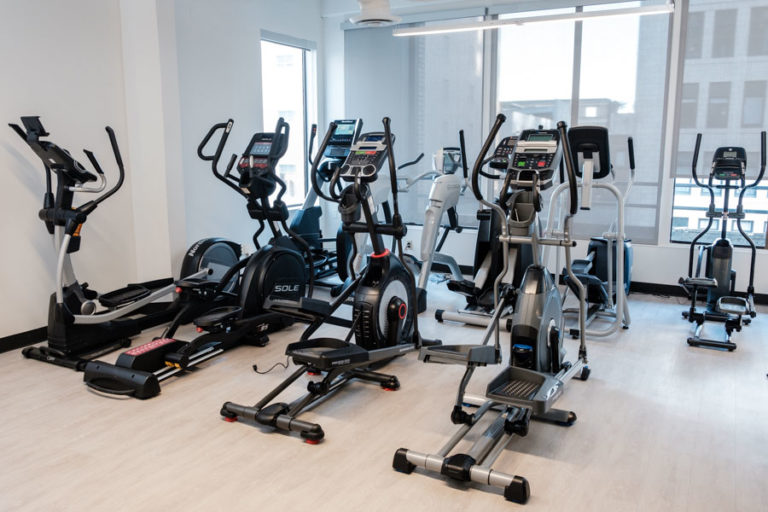
We spent quality time with each machine: exploring programs, sampling max inclines and high intensities, debating ergonomics. We crushed ourselves with interval courses and mountain climbs. We found tiny muscles in our shoulders we didn’t know we had. Through it all, we judged every model on a focused set of considerations: The smoothness and naturalness of the ride was our top concern, followed by the clarity of the console and its programming. These two features are critical factors in the quality of your workout, and any elliptical that failed one or both isn’t worth the money. The overall ergonomics of the machine’s design, and the ease of making adjustments will affect the experience of your workout, so we also looked at them closely, though they carried slightly less weight in our overall consideration.
Ride Feel
All three design factors (drive system location, drive mechanism, and pedal style) contribute to ride feel. While some design choices will always provide for more natural movement (i.e., suspension feels more free than wheel track), we expected that any worthy model would offer a satisfying stride length, smooth-sliding pedals, and arm handles that swung in comfortable unison with pedal speed.
Not surprisingly, our two deluxe, center-drive models, the NordicTrack FreeStride Trainer FS9i and the Octane Zero Runner ZR7, scored high with their free-wheeling, body-powered motion. Far from being constrained to tracks, every stride has the potential to be unique. Deciding which model offers the best ride feel, our testers were divided. Both provide a level of user-directed motion totally unavailable on any of our other models. Where the Octane feels like striding around in muscular leg braces, the NordicTrack feels like cross-country skiing in zero gravity. Their drawbacks are also on-theme: The Octane made a distinctive clank with every right-footed stride; the NordicTrack left us feeling out-of-control.
Ranking ride feel between our two rear drive contenders was easier. The NordicTrack SpaceSaver SE9i and the Precor EFX 222 seem identical, and yet the NordicTrack made us feel, if possible, even more constrained than we did on the tiny front-drive units (our hands were forced against our chests when pedaling). Meanwhile, the Precor’s well-balanced architecture allowed us to naturally extend our arms and legs, adding up to a truly enjoyable elliptical experience.
The Sole E95 and the Precor competed for the best-riding, midrange elliptical. The front-drive Sole utilizes two wheels on each track, making for a seamless, super silent stride. That ride quality remained constant at any incline, but we noted that on the higher settings, our toes pointed beneath our heels. The machine lost a couple comfort points on that score.
Compact, front-drive ellipticals are not cut out for lengthy strides (maxing out at 20”), and none of the five models we looked at allowed our feet to extend farther than our knees. Apart from the spendy Sole, one other front-drive model was noticeably better than the others we tested.
The Horizon Fitness EX-59, despite being the smallest of the bunch, impressed us. Its design doesn’t plant the user as close to the console as the other front-drive models, giving us some much-needed breathing room. Even better, the wheels roll without any of the gravelly sound or feel that plagued the Nautilus E614, Schwinn 470, and Diamondback 1260 Ef. One tester went so far as it call the surprisingly deluxe ride feel on the Horizon “velvety smooth.” The bulky Diamondback forced the most staccato motion, feeling unpleasantly like stair climbing.
Console and Programming
Exercise programming, and your ability to access it, makes a big impact on user experience. While the workouts most ellipticals offer are pretty similar (fat burn and hill climb are a couple of timeless favorites), the process of locating and switching between them varies enormously. We looked for consoles that were immediately understandable and allowed for quick access to both manual start and specific programs: We wanted to be able to go from powering on to powering through a workout with minimal button pushing.
Precor EFX 222 again earned its stripes, making it possible to just jump on and hit “Go” — no negotiating Manual programming, typing in weight and age, or setting a workout duration. You can also switch between programs without pausing the present one or resetting your workout stats. We found these two features to simple but smart improvements that Precor gets right and, for whatever reason, every other model gets wrong. As one Precor tester put it, “I never had to push more than one button to get the machine to do what I expected and wanted.”

The Sole E95 also allowed for pretty straightforward workout starts, though it initially juked us out thinking the screen was a touchscreen — the screen’s size, location, and visuals all suggest it would be. One tester complained that they spent a good minute attempting to tap the screen just right, before realizing that the understated buttons beneath the screen were the actual controls. Unlike the Precor, it demands user metrics before you can get started. Worse, in order to make weight and age adjustments, you can’t just hold down the arrow button down and scroll through numbers: You have to tap up or down one integer at time. We wanted a cardio workout, not a test of our patience.
On the far end of the usability spectrum, the Diamondback consoles contains a multitude of brightly colored, finicky buttons. Rather than pare it down to essential controls to lead you through a computerized menu of workout options, the console gives an individual button for every function. However, none of them work unless you first hit the “parent” button awakening that row of controls. We found that models that load up on buttons, like the Diamondback and, to a lesser extent, the Nautilus and Schwinn, were more aggravating to use. The clean simplicity of Precor and Horizon consoles made programming intuitive and speedy.
Of course, beyond pared down buttons, there’s the option of no buttons at all. The two NordicTrack ellipticals feature the highest level console tech: a touchscreen. However, the discrepancy in touchscreen quality between the more accessibly priced SpaceSaver SE9i and the deluxe FreeStride Trainer FS9i tells you everything you need to know about onboard screens. While the fitness and entertainment features that live inside the two touchscreens are the same, the experience of using them is surprisingly different. The small, largely unresponsive touchscreen on the lesser model made just starting a workout a pain. “Unless it’s a screen that competes in size and clarity with my laptop, I don’t want it,” one tester told us. A more spacious, sensitive touchscreen, with room for your fingers to hit the right buttons, is an upgrade, but we still felt hamstrung by the necessity of connecting to internet.
NordicTrack incessantly attempts to funnel users into iFit, which reduces their equipment’s overall usability. If you can’t connect to internet, or just aren’t interested in subscribing to iFit, you have to back out of advanced options before you’re able to start a manual session. Call us crazy, but we’d rather not need to exit out of things just to get to the main menu.
Surprisingly, the most futuristic elliptical of all, the Octane Zero Runner ZR7, not only doesn’t offer a touchscreen, but has the most mysteriously understated control panel we’ve seen: a transparent plastic screen and five unlabeled buttons. When testers jumped on cold, they couldn’t get pretty much any programming to work. However, it was easy enough to operate after scanning through the manual (which we recommend for any elliptical, no matter how intuitive it looks. Even still, the programming options are lacking compared to other machines: minimal intensity levels (you can swivel a pair of cuffs to go change resistance) and no incline options.

The Zero Runner had one of the least intuitive consoles we tested.
Ergonomics
A good elliptical should keep everything in reach during your workout. We wanted to be able to comfortably access all controls, arm handles, and shelving at any point during our workout.
Unfortunately, one of the first things to interfere with ergonomics is upping the incline. When the Nautilus and Schwinn are set to max incline, their water bottle holders are comically far away. So are the stationary heart rate handles. Anyone taller than about 5’2” will have to bend down in order to reach those features. Meanwhile, when you are at a mid to low incline, the media tray is too far up the console to hold reading material. And the Horizon’s water bottle holder is just placed super low, regardless of incline — it sits just a couple feet off the floor, at the top of the flywheel. You have to stop all motion and lean forward, ducking your head between the heart monitor handles to reach it.
Other machines had uncomfortable handle positioning no matter the incline. The Diamondback’s moving handles are placed far away from the user, causing our arms to shoot and our elbows to be pulled taut. The NordicTrack SpaceSaver had a similar problem, though the worst part is how it punched our hands back in against our chests while we were running.
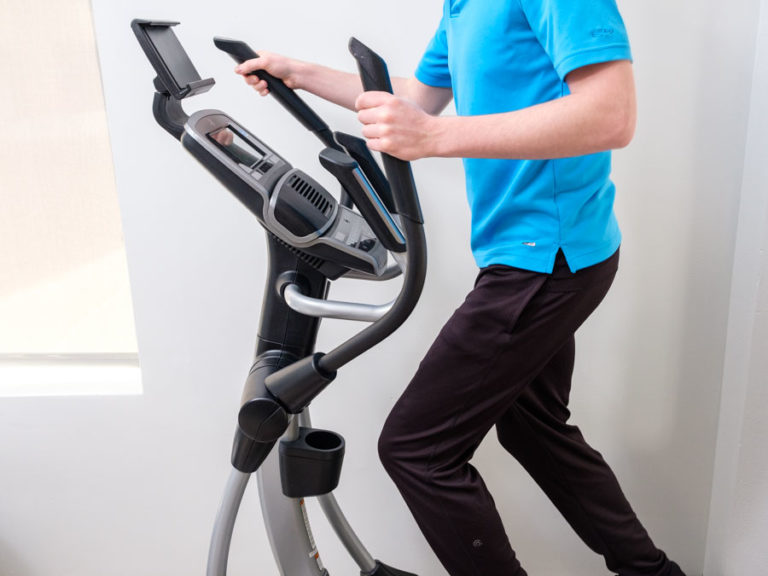
Our testers felt uncomfortably close to the console when using the SpaceSaver.
Here’s the deal with elliptical handles: Using them doesn’t feel that great and isn’t that great for you. We heard a lot of noise about how pumping your arms means you’re increasing heart rate and getting a full-body workout, but we talked to a physical therapist who told us otherwise. Mitch Owens of Seattle’s Union Physical Therapypoints out that the unnatural position of arms while using elliptical handles doesn’t jive with our biomechanics. It also doesn’t make for a very effective arm workout — unless you’re actively recruiting your arms, they’re just along for the ride. One of our testers mentioned that he vastly preferred keeping his hands and arms on the stationary heart monitor, finding that the moving handles “had a confusing motion and distracted from my workout.”
The best handles of the lineup simply make the best of a bad situation. Sole’s unique, looped design allows for multiple arm positions; Precor’s handles are convenient and reachable; the bigger NordicTrack, which hoists you up higher in the air, lets your arms move closer to chest height. The Octane Zero Runner eschews the typical long bar handles in favor of two short, inward-curving grips, which we liked. We found our arms moving in a similar motion as they would while running.
Incline Adjustments
Most ellipticals offer the ability to adjust incline to vary the intensity of your workout. We looked for ellipticals that could achieve a challenging tilt without disrupting our workout momentum.
In our line-up, a couple models don’t offer it at all. Either because their range of motion wouldn’t be served by it (Octane Zero Runner ZR7) or because the manufacturer is keeping down costs (Horizon Fitness EX-59). Of the remainder, two require manual incline adjustments.
The Nautilus E614 makes it easy to locate the proper levers with a vibrant blue catch and clear instructions. The Precor EFX 222 is less apparent. The small, dark gray latch has just a small safety warning that clued us into its purpose. Neither requires much arm strength. We were a little annoyed to have to clamber on and off these machines every time we wanted to test a different pitch, but ultimately found that different inclines didn’t affect our effort level nearly as much as intensity. Very likely, you’ll just set incline once before you start your workout.
Our two NordicTrack models, the mid-range SpaceSaver SE9i and high-end FreeStride Trainer FS9i, both offer speedy, silent auto adjustments. The Diamondback wheezes laboriously when you ask it to raise or lower, and, surprisingly, the higher incline you select, the more constrained your movements. We had a similar experience with the Nautilus and Schwinn twins. If you go to max incline (the typical 10 degrees), your stride feels short and your feet point downhill.
The moral of the story: We appreciated when incline adjustments were quick and painless, but found that incline itself did not strongly impact our workout.
What we found:
Our favorite machines were quiet and smooth, lent themselves to natural movements, and made it easy to push our limits. Our least favorite machines had laborious movements, confining designs, and non-intuitive controls.
| Elliptical | Drive System | Pedal Design | Price |
|---|---|---|---|
| Precor EFX 222 | Rear drive | Wheel track | $2,495 |
| Horizon EX-59 | Front drive | Wheel track | $999 |
| NordicTrack FreeStride Trainer FS9i | Center drive | Suspension | $2,999 |
Our Picks for the Best Elliptical
Best Overall
Precor EFX 222Intelligent design choices make this classic elliptical truly exceptional. A joy to ride.
Our testers unanimously loved this machine. Smooth and silent, the Precor EFX 222’s streamlined design makes for easy riding and easy adjustments. Though the pedals are confined to a track, we didn’t feel restricted like we did on the similar NordicTrack SpaceSaver SE9i. The machine as a whole is designed ergonomically: For example, the handles allow for a comfortable reach that doesn’t force the arm to become hyperextended on the push or compacted on the pull.
Most of the ellipticals we tested either forced us to toy with a small, grainy touchscreen that functions half the time, or experiment with a keyboard of mysteriously labeled buttons. Precor pares it down with a refreshingly simple console. Its crisp digital screen shows all the usual calorie, distance, and heart rate metrics, plus your workout progress on a blinking graph. It was the only elliptical we looked at that gives heart rate both numerically and as a bar that charts against heart rate zones (warm-up, fat burn, cardio, high). Just one of Precor’s many simple-yet-genius features.

Apart from a couple of resistence toggles, the only other thing on the console is a set of soft, sliding pincers that adjust to hold your device at face-height. This is such a brilliant no-brainer, we were stunned. Because why would anyone want to use an outdated touchscreen, if that’s all the price bracket offers? Just about everyone has a state-of-the-art smartphone or tablet that can be put to work if a virtual tour of Hawaii or a daytime drama bingefest keeps you going.

We appreciated Precor’s intelligent, low-key design choices in everything from the device holder to the foot pedals (long instead of wide, with a raised lip on all sides). One complaint: It’s not immediately obvious how you make the manual incline adjustments. There’s no color coding — everything’s in undifferentiated grey — and there isn’t much in the way of markings to tell you where to press, tug, or give up. Once you do locate the correct panel, however, it’s an easy chore. And don’t let the fact that it’s manual rather than automatic deter you — you may have to DIY, but its 25-degree max incline is second only to the 28-degree Diamondback.
If no automatic incline is a dealbreaker for you, we recommend the Sole E95 — but only if you can find it at a discount price. The Sole’s MSRP is even higher than our super-deluxe, suspension-pedal contenders at $3,400. However, you can find it on Amazon and elsewhere for $1,800, and at that price it beats the Precor by $700.
Best Budget
Horizon EX-59Strong and smooth, this simple machine eschews extras and focuses on getting the important things right.
Minimalist by nature, this pint-sized Horizon might not boast much in the way of extras, and doesn’t offer any incline at all, but what it does provide, it gets right — like the silent gliding track and powerful resistance. Its intensity levels number just 1-10 while most others offer 1-25, but we found that we had to pump our legs every bit as hard. The resistance numbering turns out to be the perfect metaphor for the Horizon: It can do everything bigger and flashier ellipticals can do, but doesn’t brag about it.
The tiny console is about half the size of typical ellipticals’, and we appreciated its pared-down simplicity. In our experience, more buttons and more options don’t substantially improve a workout, they just add complication. A small, lime-green screen gives clear indications of the essentials: progress, time, calories burned, and heart rate. It also presents your heart rate numerically rather than as a bar on an intensity graph, which is all that’s available on the similarly priced Nautilus and Schwinn models.

When we compared the three of them (all front-drive ellipticals around $600), we were impressed that the Horizon’s diminutive size offered more solid construction and more intelligent controls. The taller options were both guilty of substantial shaking, especially when we upped the intensity and our effort. The gritty, rolling sensation of pedaling on them prompted one tester to describe it as “like riding a skateboard over a ridged surface.” The Horizon, on the other hand, remained sturdy and exceptionally smooth, no matter how much power we exerted.
The greater quality of the Horizon is reflected in its MSRP, which is almost double that of the Nautilus and Schwinn. However, retailers like Amazon cut it down to size — from $999 to $650.
Best Upgrade
NordicTrack FreeStride Trainer FS9iKeep your body surprised and your mind engaged with this incredibly engineered elliptical from the future.
The NordicTrack FreeStride Trainer FS9i is a next-level machine. An evolved elliptical, it falls into the alternative motion trainer (AMT) category and, once again, followed Precor into the genre. AMTs offer the motion of jogging, running, and climbing all in one superiorly ergonomic machine. The prices may hurt your eyes, but these ellipticals are certainly easy on the joints. Precor produces only commercial-grade AMTs that cost $10,000-plus; NordicTrack and a few other manufacturers have repackaged the idea for home use.
Springy, suspension foot pedals allow for an incredible range of motion (not to mention a stride of up to 38”), from loping strides to concentrated jogs. Moving on the NordicTrack FreeStride felt a bit like like running through water — the motion wasn’t quite as easy as actual running, but it was pleasantly weightless.
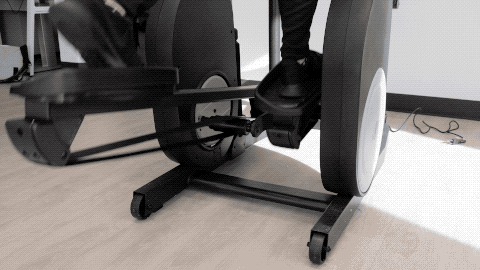
Perhaps not surprisingly, some of our testers struggled to get the hang of it. With so many moving joints, there’s the potential for each step to be different. But with practice, it becomes an excitingly freestyle ride, and the effort needed to keep your strides equal becomes part of your mental engagement with your workout. Depending on your preferred workout style, you might find this to be pleasant — if you like the concentrated focus of yoga — or frustrating — if you prefer to let your mind wander during workouts. It helps to keep an eye on the cadence (number of pedal revolutions per minute) to make sure you’re evenly working out every quadrant of your body.
Like the lesser NordicTrack SpaceSaver, the FreeStride features incline and resistance controls embedded in the handles. The FreeStride’s are even better, however, because they’re conveniently set where your palms naturally fall. Instead of reaching up to the crown of the handle, you can just wrap your fingers forward a couple inches.
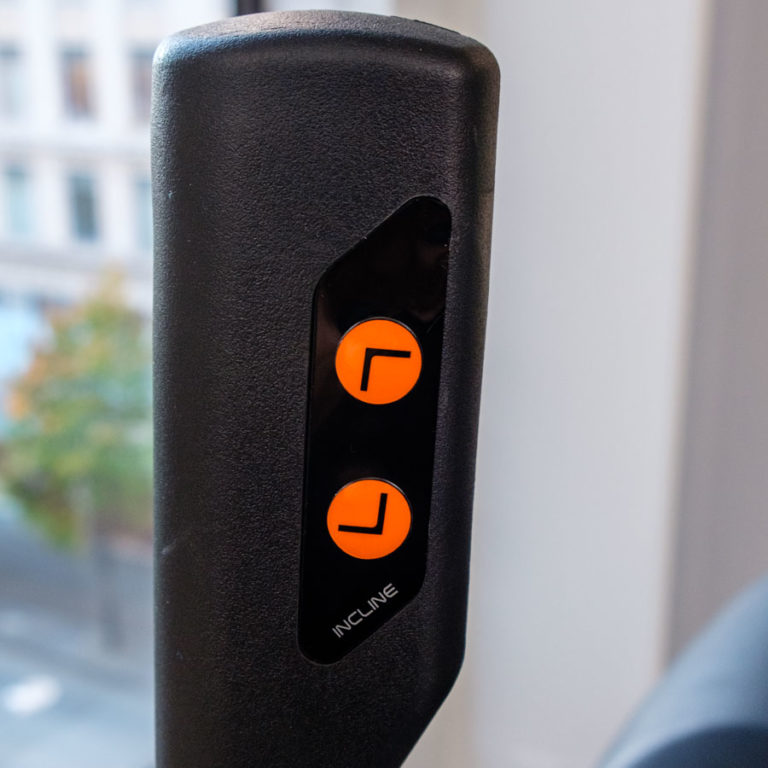
Another upgrade from its SpaceSaver counterpart: the incredibly high-definition touchscreen. Its precise image quality made the same features we found in the SpaceSaver seem like an entirely new system. We ended up having trouble with the console buttons — we had to press them very hard, which isn’t always practical mid-workout — so we appreciated the extra space on the touchscreen. That said, NordicTrack’s tendency to put iFit front and center continued to detract from our workout experience.
While the NordicTrack FreeStride reimagines the elliptical mold, the Zero Runner throws away the whole blueprint. Its unharnessed pedals stretch to an incredible 58” max stride length and allow for jogging, running, and leaping movements. This is a wholly user-powered make, without any workout programming and hardly any resistance levels to speak of. If you like the sounds of a truly experimental piece of exercise equipment that will make you ask yourself “How do I run without a surface?” “What is running?” and “What are glutes?” then you may find yourself as enamored with this machine as some of our testers (especially the taller, more experienced runners).
But if you would prefer more uniform, even movement and a directed workout, let us steer you back to traditional elliptical territory. The FreeStride Trainer offers a happy medium between the traditional elliptical and the workout of the future. We loved its springy, bounding sensation and the extensive line-up of workout programming; a lot is available even without shelling out for an iFit subscription.
There is also price consideration between the two models. The Octane Zero Runner carries an MSRP $300 above the NordicTrack FreeStride — $3,299 vs. $2,999. But while we didn’t find any retailers beating NordicTrack’s MSRP, we did find the Zero Runner for just $2,475. We liked elements of each, but for overall experience and ease-of-use, we feel the NordicTrack is the better buy.
Elliptical vs. Treadmill
It’s a question as old as time: Are elliptical workouts as effective as running? The answer is… almost.
An elliptical can exert the heart and leg muscles in a manner similar to a treadmill, but the low impact design means you won’t feel like it. Your heels remain in contact with the pedals as you move, placing less stress on muscles and tendons and consequently giving you a lower RPE (Relative Perceived Exertion.) “People actually work harder than they perceive when training on a elliptical,” says strength and conditioning coach Derek Zahler, author of The Tactical Fitness Manifesto. “Particularly where interval training is involved, athletes underestimate their output and heart rate zone. And since you’re typically using different muscle groups in concert on an elliptical than you would on another piece of equipment, and because you don’t feel overworked, you’re likely to continue to work harder, or exercise longer, to burn more calories and have faster weight-loss results.”
Physical therapist Mitch Owens describes low-impact vs. high-impact exercise as a trade-off: “Increase impact, get a better workout.” If you want to make your low-impact elliptical workout compete with running, Owens said, you have to “go crazy turbo on it.” Set the resistance to high and elongate your strides to maximize muscle engagement and calorie burn. Let go of the handles to focus on core stabilization.
Owens acknowledged that the constricted motion of on an elliptical isn’t exceptionally beneficial for muscle development, or that natural for the body. In fact, “your hips go through a greater range just walking around, running, or climbing stairs.” Still, Owens was quick to point out that the movements we are built for — walking and running — aren’t necessarily the best calorie-burners. The very unnaturalness of the elliptical movement may be what makes it a surprising and therefore effective workout. Exercise variety is a benefit specific to ellipticals — change it up with pre-programmed routines, utilize forward and backward pedal movement, and vary hand positioning. Workout diversity is known to promote peak physical health.
Did You Know?
There’s more than one style of elliptical to love.
Reclining or Recumbent Ellipticals are great for overweight or novice exercisers says Boulder-based body worker and assistant manager at Healthstyles Exercise Equipment Todd Olson. “The seats on recumbent machines are usually a lot more comfortable and inviting for consistent use: There is very little pressure on the knees and ankles as you pedal,” he explains. For those who are hunched over during their daily work, a recumbent machine is likely better than a regular spin bike, and perhaps better than an upright bike if you can't maintain good posture for long. “With the lower center of gravity, recumbent bikes are also a little safer and more stable than uprights and spin bikes, and easier on the hands and wrists.”
Elliptical Gliders, unlike typical elliptical machines, keep your legs straight as you swing them back and forth. Your arms also tend to be more engaged in powering the glider’s motion, as their movement ratio is more or less equal. Gliders or gazelles are simple machines (like a pair of skis with attached poles) and come pretty cheap -- typically less than $200.
Lateral-movement ellipticals let users move both forward and backward and side to side. This offers big benefits for athletes in sports with a lot of lateral movement (tennis, soccer, basketball) but it's good for everyone “to counterbalance all the movement we typically do in the sagittal plane: forward and backward, but mostly forward,” says Olson. “Working our muscles in the frontal plane (side to side) helps stabilize and balance the musculature around our hips, pelvis, knees, and ankles. This can have the added benefit of easing any low-back issues.”
Vive La Résistance.
Gym Source advises upping the set resistance level on your elliptical by 10 percent each week. Make sure there’s plenty of overhead to do so when buying: the available resistance levels on your elliptical of choice should start challenging you at about 75% their max. You want a healthy margin for growth.
Isn’t impact good for bone health?
Scientific advisor to the National Osteoporosis Foundation, Dr. Robert Recker told The Washington Post that many people overemphasize the importance of weight-bearing exercise in improving bone health. “Anything you do is good for the skeleton,” he affirms, and that includes even extremely non-weight-bearing exercises like swimming. While the bones of an athlete who frequently experiences impact may be denser, the difference in bone density between average exercisers is minimal. The benefits of an elliptical machine workout in terms of bone density is comparable to a run.
Give your elliptical some love.
Most fitness equipment — ellipticals included — have a 10- to 20-year lifespan if well cared for. Frequently check that foot pedals, hand grips, and screws are tight and functioning. Wipe the machine after each use with a non-toxic cleanser to keep bacteria at bay. And keep your elliptical’s joints as healthy as they keep yours: all moving parts of exercise equipment should be regularly lubricated. On a less-frequent basis, check the power cord for fraying. Bi-annually, unplug the machine and open the cover to check the drive belt for wear. If any of these parts seem to be functioning less than optimally, contact your manufacturer.
The Best Elliptical Machine: Summed Up
More Elliptical Machine Reviews
We've been digging deep into Treadmills for several years now, and have published additional reviews for specific needs. Check them out below:

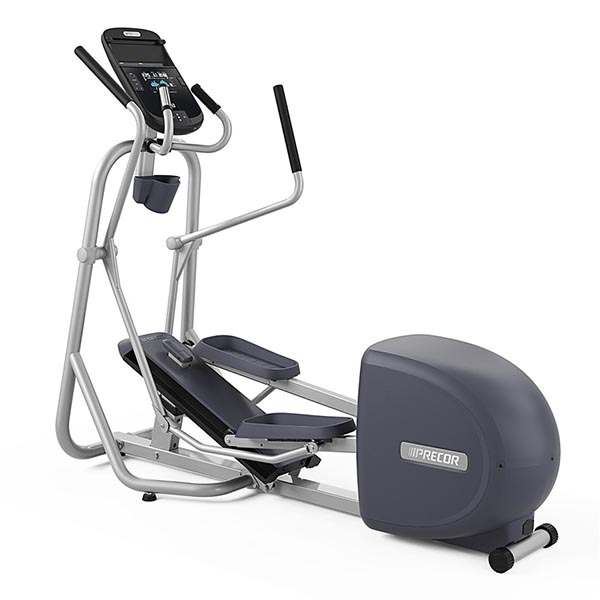
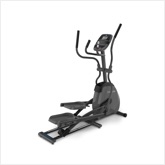
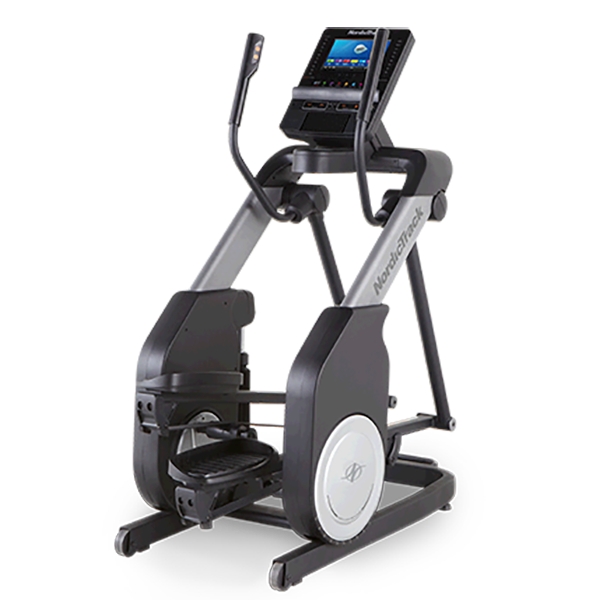

No comments:
Post a Comment